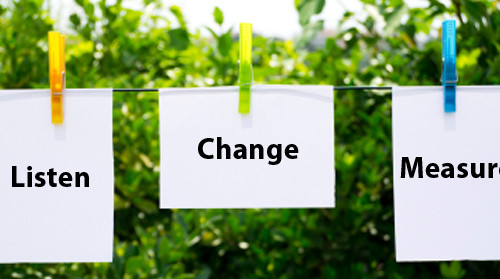Every time someone asks me exactly what they can do to make their business become social, I find myself launching into a passionate monologue about behavioural triggers, social objects, offline and online integration, the value of engagement, and so on and so forth.
With this becoming an increasingly lengthy process, I’ve decided that next time I’m faced with that question I’m going to use three simple words.
Listen. Change. Measure.
The great thing is that this works both internally and externally. How? Lets tease it apart.
Listen. For consumers, this means finding out who is talking about you in social media, where, why, to who, what they are saying and how positive that conversation is. It also means benchmarking that against competitor conversation and listening for the unexpected patterns and trends: what other passions do people who love you also have? If there’s no conversation about you, what other topics are relevant to what you do? Are your audience even there at all? Internally, this means fully understanding how social your culture is right now. Auditing as many people in the company as possible about their behaviours, attitudes, hopes, fears and aptitudes about using social tools and engaging with each other and consumers in a transparent, seamless and inspiring way. This is essential if you are to measure something as subjective as cultural change.
Change. ‘Creating buzz’ isn’t good enough. A truly successful social project must change some sort of dial, be that in reaching new audiences, increasing sales, improving customer service, securing loyalty, doing more internal business deals, better inter-department communication. Any strategy must be focused on shifting behaviours, not just generating talk – and that’s hard to do. The strategy must come from the listening. How can you align with people’s existing passions and needs (be they consumers or colleagues)? How can you make the change productive and valuable for them? How can you give them control of the change? How can you make it feel good?
Measure. You need to have KPIs in place from the start. Make sure they’re the right ones, because you’ll value – and pursue – what you measure. If you care about garnering thousands of Twitter followers, fine. But if you care about people actually feeling differently about you, you’re going to have to be measuring depth, frequency and nature of engagement, positivity, breadth of platforms and much more. Internally, what do you really want to improve? Speed and flexibility of communication? Bringing down departmental barriers? More lateral thinking and risk-taking? Externally, you’ll have large-scale data to gather and interpret; internally, re-auditing people on those attitudes and aptitudes will be key to judging success.
I believe that the external social change can only begin with internal social change. The great thing is, the process works the same way. Sure, you might be creating strategies and content plans and engaging bloggers and building apps and setting up internal platforms. But are you truly listening, changing and measuring every step of the way? The simplest questions are the hardest.
Any marketer worth their salt trips out the old truism that brands should be ‘more human’ in social media. But this year, a number of social media related experiences have planted a slow realisation in my brain. The fact is, brands acting like human beings in social media is sure fire route to disaster.
At an Exeter-based conference – Like Minds – one of the Guardian’s Top 10 Global Ideas Festivals, a colleague and I decided to use our workshop to conduct a modest experiment. We challenged participants to investigate whether they could use social media to shift behaviours rather than just generate talk. Within half an hour, they had to get someone within their network (but who they hadn’t met in real life) to either donate to a specific Exeter charity, including the hashtag #likemindsdoers in their Justgiving comment; or to buy a cup of Starbucks coffee, get the barista to write the hashtag on the cup, and upload a photo as proof.
What was interesting was their reaction to being personally asked to achieve social objectives that brands – sometimes their own – chase without question every day. No-one listened first and then personally targeted relevant individuals; they threw messages into the ether and hoped one stuck. One resorted to bribery; another piggybacked off popular hashtags. They SHOUTED. They cajoled. And even the ethical ones failed to impel their likeminded networks to donate a single pound to a worthy local cause.
This is no reflection on the character or skills of the participants, who were incredibly good sports. But it is a reflection on the hypocrisy of our insistence that brands be human online. Because much of the behaviour we as individuals display in social media is underpinned by an (conscious or not) agenda of personal branding. How many of your friends use their presences to basically declare their own awesomeness, uploading their on-trend outfits and selectively broadcasting their most exciting cultural activities? How many treat them as broadcast channels, continually trying to get you to read their blogs or attend their events?
What we really mean when we say that we want brands to be human online is that we want them to act out a persona of flawless humanity. Far from enhancing their ‘authenticity’, this reveals just how inhuman we prefer them to be. We want them to be warm and friendly yet available 24/7. To respect our privacy but hide nothing from us. To adore what they do but not talk about it too much. To be personal on a mechanical scale. And as they strive to act more like us, we start to become more like them.
An organized group of people (a business) cannot act like an individual. Being social as a business takes new and unique skills and strategies, including boundary setting that reminds others what it can and can’t (and is and isn’t willing to) do. As for the rest of us?
Well, practising not being self-obsessed morons would be a good place to start.






